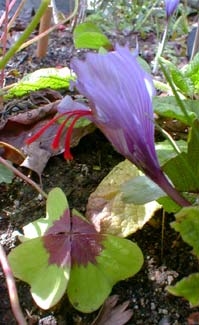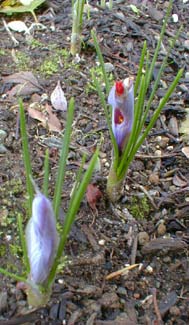
Autumn-flowering
Saffron Crocus
"Eastward the dawn has broken red,
The circling mists & shadows flee;
Aurora rises from the sea,
And leaves the crocus-flowered bed."
Oscar Wilde,
1881
1881
In October, the flower-bud & short rigid crocus-grass appear just about simultaneously on Crocus sativas. As shown in the second photograph, it does not take very long before the unusually long saffron-baring anthers are poking out of the bud, like bright orange-red tongues. The top photo shows one of the violet-blue or lavender-purple crocuses nearly opened, blooming at the edge of a patch of Iron Cross Oxalis. The colorful anthers are dangling completely outside the saffron crocus's throat.
Saffron blooms do occasionally get tippy, & can be ruined by a hard rain, but they have comparatively sturdy upright flowers which, unlike C. speciosus (which also blooms autumn but with no grass until spring), does not so wholeheartedly require a bracing companion to uphold the flowers. They do nevertheless benefit from growing out of a groundcover.
When they do well, the Saffron Crocus is one of the most striking of the autumn crocuses, those three intensely orange-red female style lifting high out of the cup of petals. The majority of autumn-blooming crocuses are various shades of purple or violet, but saffron crocus is lent an obvious distinction because of those brilliant red style.
They like full sun to just a touch of shade, but in our Zone 8, the mmore sun the better, in a location with extremely well-draining soil. In autumn 2002 we planted ours under a young Pin Oak where they get a great deal of morning sun but dappled shade the rest of the day, blooming as they do before the deciduous trees have fully dropped their leaves to let in more sun. Full morning sun seems to be sufficient, & as they were along a rockery ledge, so they get the sharp drainage they require. When the blooms are spent, the trees' canopy will be leafless, so that the saffron's grass gets increasing sunlight by which to recharge the bulbs for the next year.
This patch bloomed feebly that immediate autumn when planted, but a year later in Autumn 2003 they were quite flowery. The blooms are not as long lasting compared to C. speciosus & C. pulchellis. After a couple weeks of flowering, a hard rain beat the saffron blossoms down, & thereafter there was only crocus grass.
Although they had done well enough under the Pin Oak, I knew they would do better still in a dryer garden more fully sunned. I also worried about the requirement that saffron crocus be dug up every few years to divide bulbs; this could be bad for the Pin Oak's roots to dig around them at intervals.
Though it's best to wait until spring die-back of winter's crocus-grass to dig them up, divide them, & replant, our winters are so moderate, & myself so impatient, that I decided I'd jump the gun, even if it stressed the hardy bulbs somewhat. I dug them up in December & replaced them with Cyclamen cilicium which are better suited to living amidst a tree's roots & unlike the saffron crocus will never need to be dug up. The saffrons I moved to a streetside sun garden & planted them near the base of a Euphorbia called 'Lambrook Gold.' A dwarfish sunrose will doubtless spread over them & serve to brace the blossoms come another autumn.
 The Saffron crocus, native to Europe & western Asia, is grown both as a food crop & as a garden ornamental. It is the source of the spice industry's most expensive spice, saffron being made from drying this crocus's tiny flower stigmas.
The Saffron crocus, native to Europe & western Asia, is grown both as a food crop & as a garden ornamental. It is the source of the spice industry's most expensive spice, saffron being made from drying this crocus's tiny flower stigmas.Formerly saffron was used as a yellow dye but was so pricy that modern chemical dyes have displaced it. It remains a popular spice for whomever can afford it. It can take a quarter-million stigmas to add up to one pound of saffron, & each blossom only provides three stigmas. Happily it doesn't take much saffron to transform plain rice into a very pungeant meal, & more than a dash of it would be too bitter. It can also be steeped with tea, or added to sweet rolls, muffins, or fish.
Stigma or style (the female sex organ of the flower) stands out as the longer redder threads inside the flower, often long enough to dangle entirely outside of the petals. The shorter male organ is yellow & has no flavor, but is occasionally harvested along with the three female threads just to add bulk to the harvest, even though this cuts the intensity of the flavor.
It is believed that this crocus first appeared in Crete as a triploid form of a Greek species, Crocus cartwrightianus. Being triploid causes the flowers to be sterile & it reproduces only by offsets on the corms. When I moved this saffron drift, it was interesting to see what a great many offsets they had produced in little more fifteen months.
As sterile flowers their only method of reproduction is by these offsets, & they produce a lot of them.The fact that saffron crocus spread throughout Europe to India thence to China, even as a sterile flower that cannot self-seed, was due entirely to ancient trade routes of IndoEuropean traders who even in the days of Minoan high culture valued the spice as they would gold & rubies.
As a high-value crop known also as "Vegetable Gold," it is now grown from Spain to Kashmir to Iran. As a crop it is today largely restricted to hot somewhat dry regions, though in medieval times it was successfully grown for harvest in temperate areas; Essex was briefly a center of saffron production in England. As a garden ornamental it more certainly does fairly well in temperate climates too, & was introduced as far north as Switzerland by the 15th Century.
Among the Minoans this flower was sacred to the Mother Goddess, whose priestesses wore garments dyed red & yellow with saffron. For a full discussion, see the page about the multiplicity of Ancient Cultic Associations of Saffron Crocus.